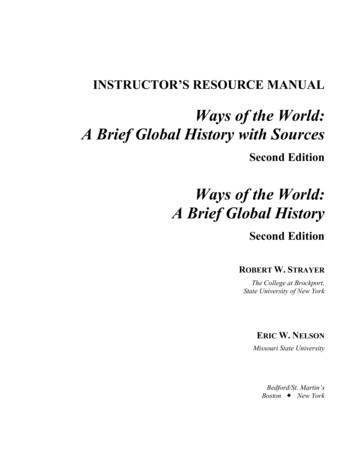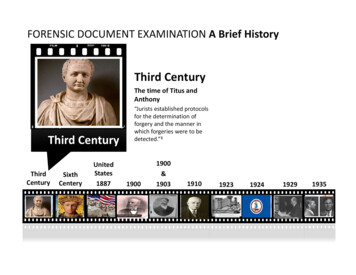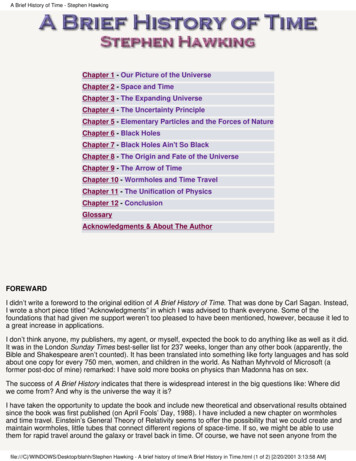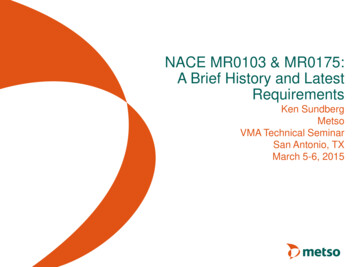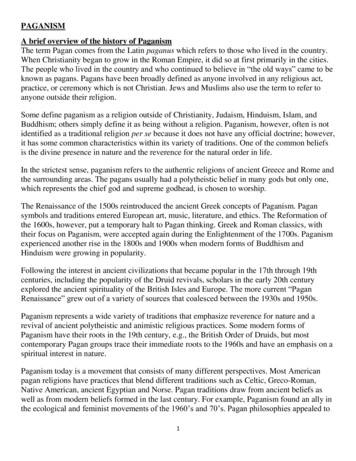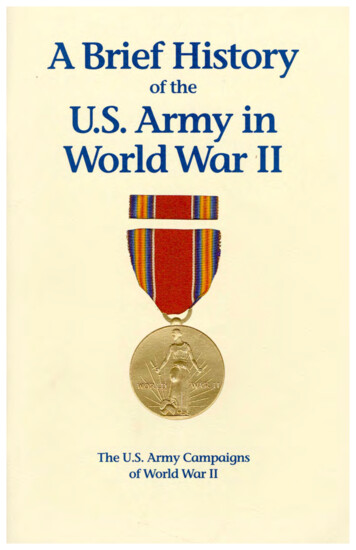
Transcription
A Brief Historyof the U.S. Armyin World War IICENTER OF MILITARY HISTORYUNITED STATES ARMYWASHINGTON, D.C., 1992
IntroductionWorld War II was the largest and most violent armed conflict inthe history of mankind. However, the half century that now separatesus from that conflict has exacted its toll on our collective knowledge.While World War II continues to absorb the interest of military scholars and historians, as well as its veterans, a generation of Americanshas grown to maturity largely unaware of the political, social, and military implications of a war that, more than any other, united us as apeople with a common purpose.Highly relevant today, World War II has much to teach us, not onlyabout the profession of arms, but also about military preparedness,global strategy, and combined operations in the coalition war againstfascism. During the next several years, the U.S. Army will participatein the nation’s 50th anniversary commemoration of World War II. Thecommemoration will include the publication of various materials tohelp educate Americans about that war. The works produced will provide great opportunities to learn about and renew pride in an Armythat fought so magnificently in what has been called “the mightyendeavor.”A Brief History of the U.S. Army in World War II highlights themajor ground force campaigns during the six years of the war, offerssuggestions for further reading, and provides Americans an opportunity to learn about the Army’s role in World War II. This brochure wasprepared at the U.S. Army Center of Military History by Wayne M.Dzwonchyk (Europe) and John Ray Skates (Pacific). I hope thisabsorbing account of that period will enhance your appreciation ofAmerican achievements during World War II.M. P. W. StoneSecretary of the Army
ContentsThe War in Europe348101517212223The Pacific War2931343943.The Outbreak of War . . . . . . . . . . . . . . . . . . . . . . . . . . .The United States Enters the War . . . . . . . . . . . . . . . . . .The North African Campaign . . . . . . . . . . . . . . . . . . . . .Sicily and Italy . . . . . . . . . . . . . . . . . . . . . . . . . . . . . . . .The Cross-Channel Attack . . . . . . . . . . . . . . . . . . . . . . .Battles of Attrition . . . . . . . . . . . . . . . . . . . . . . . . . . . . .The Battle of the Bulge . . . . . . . . . . . . . . . . . . . . . . . . . .The Final Offensive . . . . . . . . . . . . . . . . . . . . . . . . . . . .Japan on the Offensive . . . . . . . . . . . . . . . . . . . . . . . . . .The Tide Turns . . . . . . . . . . . . . . . . . . . . . . . . . . . . . . . .Twin Drives to American Victory . . . . . . . . . . . . . . . . . .Aftermath . . . . . . . . . . . . . . . . . . . . . . . . . . . . . . . . . . . .MapsAllied Operations in World War II, 1942–1945 . . . . . . . . . . 12The Pacific and Adjacent Theaters, 1942–1945 . . . . . . . . . . 36Further Readings. . . . . . . . . . . . . . . . . . . . . . . . . . . . . . 45
“OMAHA Beach” by Gary Sheahan. This was the one sector of theNormandy coast where the German defenses had begun to reach theexpectations of Field Marshal Rommel, and here the Allied invasion ofFrance faced its greatest crisis. (Army Art Collection)
The War in Europe
The War in EuropeWorld War I left unresolved the question of who would dominateEurope. The tremendous dislocations caused by the war laid thegroundwork for the collapse of democratic institutions there and setthe stage for a second German attempt at conquest. A worldwide depression that began in 1929 destroyed the fragile democratic regimein Germany. In 1933 Adolf Hitler led to power the National Socialist German Workers’ (Nazi) Party, a mass movement that was virulently nationalistic, antidemocratic, and anti-Semitic. He ended parliamentary government, assumed dictatorial powers, and proclaimedthe Third Reich. The Nazi government increased the strength of theGerman armed forces and sought to overturn the Versailles Treaty,to recover German territory lost at the peace settlement, and to return to the so-called Fatherland German-speaking minorities withinthe borders of surrounding countries.The ultimate goal of Hitler’s policy was to secure “living space” forthe German “master race” in eastern Europe. A gambler by instinct,Hitler relied on diplomatic bluff and military innovation to overcomeGermany’s weaknesses. He played skillfully on the divisions amongthe European powers to gain many of his aims without war. With theItalian Fascist dictator Benito Mussolini he announced a RomeBerlin alliance (the Axis) in 1935. Meanwhile, in the Far East, theJapanese—the only Asian industrial power—coveted the natural resources of China and Southeast Asia, but found their expansionblocked by European colonial powers or by the United States. Having seized Manchuria in 1931, they began a war against China in 1937.The League of Nations failed to counter effectively Japanese aggression in Manchuria and an Italian invasion of Ethiopia. Soon Germany, Italy, and Japan became allies, facing Western democratic governments that wanted to avoid another war and the Soviet Unionwhose Communist government was widely distrusted.The people of the United States, having rejected the VersaillesTreaty and the Covenant of the League of Nations after World WarI, remained largely indifferent to most international concerns. Theyfirmly discounted the likelihood of American involvement in an-
other major war, except perhaps with Japan. Isolationist strength inCongress led to the passage of the Neutrality Act of 1937, making itunlawful for the United States to trade with belligerents. Americanpolicy aimed at continental defense and designated the Navy as thefirst line of such defense. The Army’s role was to serve as the nucleus of a mass mobilization that would defeat any invaders whomanaged to fight their way past the Navy and the nation’s powerfulcoastal defense installations. The National Defense Act of 1920 allowed an Army of 280,000, the largest in peacetime history, but until1939 Congress never appropriated funds to pay for much more thanhalf of that strength. Most of the funds available for new equipment went to the fledgling air corps. Throughout most of the interwar period, the Army was tiny and insular, filled with hard-bitten,long-serving volunteers scattered in small garrisons throughout thecontinental United States, Hawaii, the Philippines, and Panama.Yet some innovative thinking and preparation for the future tookplace in the interwar Army. Experiments with armored vehicles andmotorization, air-ground cooperation, and the aerial transport oftroops came to nothing for lack of resources and of consistent highlevel support. The Army did, however, develop an interest in amphibious warfare and in related techniques that were then being pioneered by the U.S. Marine Corps. By the outbreak of war the SignalCorps was a leader in improving radio communications, and American artillery practiced the most sophisticated fire-direction and -control techniques in the world. In addition, war plans for various contingencies had been drawn up, as had industrial and manpowermobilization plans. During the early 1930s Col. George C. Marshall,assistant commandant of the Infantry School at Fort Benning, Georgia, had earmarked a number of younger officers for leadership positions. Despite such preparations, the Army as a whole was unreadyfor the war that broke out in Europe on 1 September 1939.The Outbreak of WarDuring March 1938 German troops had occupied Austria, incorporating it into the Reich. In September Hitler announced thatthe “oppression” of ethnic Germans living in Czechoslovakia was intolerable and that war was near. England and France met withHitler (the Munich Pact) and compelled Czechoslovakia to cede itsfrontier districts to Germany in order to secure “peace in our time.”Peace, however, was only an illusion. During March 1939 Hitlerseized the rest of Czechoslovakia by force of arms and then turned4
his attention to Poland. Although Britain and France had guaranteed the integrity of Poland, Hitler and Josef Stalin, dictator of theSoviet Union, signed a secret, mutual nonaggression pact in August 1939. With the pact Stalin bought time to build up his strengthat the expense of Britain and France, and Hitler gained a free handto deal with Poland. When Hitler’s army invaded Poland on 1September 1939, World War II began.While German forces overran western Poland, Soviet troops entered from the east to claim their portion of that country. France andBritain declared war on Germany and mobilized their forces. Thesubsequent period of deceptive inactivity, lasting until spring, becameknown as the Phony War. Nothing happened to indicate that WorldWar II would differ significantly in style or tempo from World War I.But the years since 1918 had brought important developments inthe use of tanks. A number of students of war—the British Sir BasilLiddell Hart and J. F. C. Fuller, the Frenchman Charles de Gaulle,the American George S. Patton, and the Germans Oswald Lutz andHeinz Guderian—believed that armored vehicles held the key torestoring decision to the battlefield. But only the Germans conceived the idea of massing tanks in division-size units, with infantry,artillery, engineers, and other supporting arms mechanized and allmoving at the same pace. Moreover, only Lutz and Guderian received the enthusiastic support of their government.In the spring of 1940 their theories were put to the test as German forces struck against Norway and Denmark in April; invadedthe Netherlands, Belgium, and Luxembourg in May; and late in thesame month broke through a hilly, wooded district in France. Theircolumns sliced through to the English Channel, cutting off Britishand French troops in northern France and Belgium. The FrenchArmy, plagued by low morale, divided command, and primitive communications, fell apart. The British evacuated their forces fromDunkerque with the loss of most of their equipment. The Germansentered Paris on 14 June, and the French government, defeatist anddeeply divided politically, sued for an armistice. The success of theGerman Blitzkrieg forced the remaining combatants to rethink theirdoctrine and restructure their armies.With his forces occupying northern France and with a puppetFrench government established in the south, Hitler launched theLuftwaffe against the airfields and cities of England to pave the wayfor an invasion. Britain’s survival hung by a thread. From July to October 1940, while German landing barges and invasion forces waitedon the Channel coasts, the Royal Air Force, greatly outnumbered,5
drove the Luftwaffe from the daytime skies in the legendary Battleof Britain. At sea the British Navy, with increasing American cooperation, fought a desperate battle against German submarine packsto keep the North Atlantic open. British pugnacity finally forcedHitler to abandon all plans to invade England.In February Hitler sent troops under Lt. Gen. Erwin Rommel toaid the Italians who were f ighting against the British in NorthAfrica. German forces coming to the aid of the Italians in theBalkans routed a British expedition in Greece, and German paratroopers seized the important island of Crete. Then, in June 1944,Hitler turned against his supposed ally, the Soviet Union, with thefull might of the German armed forces.Armored spearheads thrust deep into Soviet territory, driving toward Leningrad, Moscow, and the Ukraine and cutting off entire Sovietarmies. Despite tremendous losses, Russian military forces withdrewfarther into the country and continued to resist. Nazi expectations of aquick victory evaporated, and the onset of winter caught the Germansunprepared. Thirty miles short of Moscow their advance ground to ahalt, and the Soviets launched massive counterattacks.The Germans withstood the counterattacks and resumed theiroffensive the following spring. The Soviets, now locked in a titanicdeath struggle, faced the bulk of the German land forces—over twohundred divisions. The front stretched for 2,000 miles, from theArctic Circle to the Black Sea. Soon casualties ran into the millions.Waging war with the implacable ruthlessness of totalitarian regimes,both sides committed wholesale atrocities—mistreatment of prisoners of war, enslavement of civilian populations, and, in the case ofthe Jews, outright genocide.In the United States preparations for war moved slowly. GeneralGeorge C. Marshall took over as Chief of Staff in 1939, but the Armyremained hard pressed simply to carry out its mission of defending thecontinental United States. Defending overseas possessions like thePhilippines seemed a hopeless task. In early 1939, prompted by fearsthat a hostile power might be able to establish air bases in the WesternHemisphere, thus exposing the Panama Canal or continental UnitedStates to aerial attack, President Franklin D. Roosevelt launched a limited preparedness campaign. The power of the Army Air Corps increased; Army and Navy leaders drafted a new series of war plans todeal with the threatening international situation. The focus of militarypolicy changed from continental to hemisphere defense.After the outbreak of war in Europe the President proclaimed alimited emergency and authorized increases in the size of the Regu6
“Barrage Balloon” by Alexander Brook. The reported ability of balloons to interfere with low-level bombardment in Great Britain andGermany spurred the Army to develop a barrage balloon force forcontinental defense. (Army Art Collection)lar Army and the National Guard. Congress amended the NeutralityAct to permit munitions sales to the French and British, and large orders from them stimulated retooling and laid the basis for the expansion of war production in the future. The Army concentrated onequipping its regular forces as quickly as possible and in 1940 heldthe first large-scale corps and army maneuvers in American history.The rapid defeat of France and the possible collapse of Britaindramatically accelerated defense preparations. Roosevelt directedthe transfer of large stocks of World War I munitions to France andBritain in the spring of 1940 and went further in September when heagreed to the transfer of fifty over-age destroyers to Britain in exchange for bases in the Atlantic and Caribbean. In March 1941Congress repealed some provisions of the Neutrality Act. Passage ofthe Lend-Lease Act, which gave the President authority to sell,transfer, or lease war goods to the government of any country whose7
defenses he deemed vital to the defense of the United States, spelledthe virtual end of neutrality. The President proclaimed that theUnited States would become the “arsenal of democracy.” In thespring of 1941 American and British military representatives heldtheir first combined staff conferences to discuss strategy in the eventof active U.S. participation in the war, which seemed increasinglylikely to include Japan as well as Germany. The staffs agreed that ifthe United States entered the war the Allies should concentrate onthe defeat of Germany first. The President authorized active navalpatrols in the western half of the Atlantic, and in July, Americantroops took the place of British forces guarding Iceland.Meanwhile, General Marshall and Secretary of War Henry L.Stimson made plans to expand the Army to 1.5 million men. On 27August 1940, Congress approved inducting the National Guard intofederal service and calling up the reserves. A few weeks later thelawmakers passed the Selective Service and Training Act, the firstpeacetime draft in American history. By mid-1941 the Army hadachieved its planned strength, with 27 infantry, 5 armored, and 2 cavalry divisions; 35 air groups; and a host of support units. But it remained far from ready to deploy overseas against well-equipped, experienced, and determined foes.The United States Enters the WarOn 7 December 1941, while German armies were freezing before Moscow, Japan suddenly pushed the United States into thestruggle by attacking the American naval base at Pearl Harbor,Hawaii. Four days later Hitler declared war on the United States.President Roosevelt called on Congress for immediate and massiveexpansion of the armed forces. Twenty years of neglect and indifference, however, could not be overcome in a few days.Helpless as American garrisons in the Pacific fell to the Japanesein the spring of 1942, military leaders in Washington worked feverishly to create a headquarters that could direct a distant war effortand to turn the fledgling ground and air units into viable, balancedfighting forces. In early 1942 the Joint Chiefs of Staff emerged as acommittee of the nation’s military leaders to advise the Presidentand to coordinate strategy with the British. In March the War Department General Staff was reorganized and the Army divided intothree major commands: the Air Forces, Ground Forces, and ServiceForces. Thirty-seven Army divisions were in some state of training,but only one was fully trained, equipped, and deployable by January8
“Ex-Luxury Liner” by Barse Miller. The largest liners used by the Army,the British ships Queen Elizabeth and Queen Mary, could each carry upto 15,000 troops. (Army Art Collection)1942. Army planners of the time estimated that victory would require an Army of nearly 9 million men, organized into 215 combatdivisions, estimates that proved accurate regarding overall manpower but too ambitious for the 90 divisions that eventually were established and supported on far-flung battlefields.Lt. Gen. Lesley J. McNair, head of Army Ground Forces and anardent advocate of mobile war, oversaw the development of armoredand airborne divisions. He directed the restructuring of existing organizations as well, turning the old World War I “square” divisionbased on four infantry regiments into a lighter, more maneuverabletriangular division with three infantry regiments. A serious and continuing shortage of Allied shipping space placed absolute limits onthe size and capabilities of Army units. New tables of organizationstressed leanness and mobility, sometimes at the expense of fightingpower and endurance. Billeting, training areas, and equipment wereall in short supply. American industry had to support the nation’s Allies as well as its own military expansion. Britain needed largeamounts of munitions and equipment; and lend-lease aid, includingtens of thousands of trucks and other vehicles and equipment, played9
an important part in mechanizing the Soviet Army. Amphibious warfare required large numbers of landing craft and support vessels, yetto be built. The first U.S. troops arrived in the British Isles in January1942, but nearly a year passed before they went into action againstthe Axis. Meanwhile, air power provided virtually the only means forthe Allies to strike at Germany. The Royal Air Force began its air offensive against Germany in May 1942, and on 4 July the first American crews participated in air raids against the Continent.In early 1942 British and American leaders reaffirmed the priority of the European theater. General Marshall argued for an immediate buildup of American forces in Great Britain, a possible diversionary attack on the Continent in the fall, and a definite full-scaleinvasion in 1943. The British greeted this program with caution. Remembering the enormous casualties of World War I, they preferredto strike at German power in the Mediterranean, rather than risk adirect confrontation in haste. Although acknowledging the eventualnecessity for an invasion of France, they hoped to defer it until muchlater. Instead, Prime Minister Winston S. Churchill suggested AngloAmerican landings in North Africa, bringing the French armies inFrance’s colonies there back into the war on the side of the Allies andaiding the British in their fight against the Italians and the forces ofGerman Field Marshal Erwin Rommel. Months of lively debate followed, but ultimately President Roosevelt directed General Marshall to plan and carry out amphibious landings on the coast of NorthAfrica before the end of 1942.The North African CampaignMarshall ordered Lt. Gen. Dwight D. Eisenhower, then in England, to take command of the invasion. Meeting the Novemberdeadline required improvisation of every kind Army troops werehurriedly trained in amphibious warfare. Technicians modified commercial vessels to serve as landing ships. While General Eisenhowermonitored operations from Gibraltar, American forces, convoyeddirectly from the United States, landed along the Atlantic coast ofFrench Morocco, near Casablanca. Meanwhile, American and British troops sailing from England landed in Algeria. Despite efforts towin support among French military officers in North Africa, somefighting occurred. Nevertheless negotiations soon led to a ceasefire, and French units joined the Allied forces.While the Allies tightened their grip on Morocco and Algeria, theirtroops raced to reach strategic positions in neighboring Tunisia. A10
month earlier the British in Egypt under Lt. Gen. Sir Bernard L. Montgomery had mounted a powerful attack on the Germans at El Alamein,sending Rommel and his German-Italian Panzer Army reeling backinto Libya. If strong Allied forces could reach the coast of Tunisia,Rommel would be trapped between them and Montgomery’s troops.Awake to the threat, the Germans poured troops into Tunisia byair and sea, brushing aside weak French forces there. Axis air power,based in Sicily, Sardinia, and Italy, pounded the advancing Alliedcolumns. As torrential December rains turned the countryside into aquagmire, the Allies lost the race. Instead of catching Rommel, theyfaced a protracted struggle. While his forces dug in along the southern border of Tunisia opposite Montgomery, a second powerful Axisforce, the Fifth Panzer Army, barred the way to the Tunisian coast.A chain of mountains separates coastal Tunisia from the arid interior. In a plain between two arms of the mountains and behind thepasses in the west lay important Allied airfields and supply dumps. On14 February 1943, the Axis commanders sent German and Italianforces through the passes, hoping to penetrate the American positionsand either envelop the British in the north or seize Allied supply de-“Hill 609” by Fletcher Martin. Much of the Army’s fighting in the final offensive in northern Tunisia involved dismounted infantry attacks on prepared defensive positions in rugged hill country. (Army Art Collection)11
pots. German forces quickly cut off and overwhelmed two battalionsof American infantry positioned too far apart for mutual support,and the experienced panzers beat back counterattacks by Americanreserves, including elements of the U.S. 1st Armored Division. U.S.troops began evacuating airfields and supply depots on the plain andfalling back to the western arm of the mountains. Dug in around theoasis town of Sbeitla, American infantry and armor managed to holdoff the Germans through 16 February, but defenses there began todisintegrate during the night, and the town lay empty by midday onthe 17th. From the oasis, roads led back to two passes, the Sbiba andthe Kasserine. By 21 February the Germans had pushed through bothand were poised to seize road junctions leading to the British rear.Rommel and other German commanders, however, could notagree on how to exploit their success. Meanwhile Allied reinforcements rushed to the critical area. The 1st Armored Division turnedback German probes toward Tebessa, and British armor met a morepowerful thrust toward Thala, where four battalions of field artilleryfrom the U.S. 9th Infantry Division arrived just in time to bolstersagging defenses. On the night of 22 February the Germans began topull back. A few days later Allied forces returned to the passes.The first American battle with German forces had cost more than6,000 U.S. casualties, including 300 dead and two-thirds of the tankstrength of the 1st Armored Division.In March, after the British repulsed another German attack, theAllies resumed the offensive. The U.S. II Corps, now under the command of Maj. Gen. George S. Patton, attacked in coordination with anassault on the German line by Montgomery’s troops. American andBritish forces in the south met on 7 April as they squeezed Axis forcesinto the northeastern tip of the country. The final drive to clear Tunisiabegan on 19 April. On 7 May British armor entered Tunis, and American infantry entered Bizerte. Six days later the last Axis resistance inAfrica ended with the surrender of over 275,000 prisoners of war.The U.S. Army learned bitter lessons about the inadequacy of itstraining, equipment, and leadership in the North African campaign.Army Ground Forces acted quickly to ensure that American soldierswould receive more realistic combat training. Higher commanders realized that they could not interfere with their subordinates by dictating in detail the positions of their units. Troops had to be committedin division-size, combined arms teams, not in driblets. The problemposed by American tanks, outgunned by the more heavily armed andarmored German panzers, took far longer to correct. But the artilleryestablished itself as the Army’s most proficient arm.14
Sicily and ItalyMeeting in Casablanca in January 1943, President Roosevelt,Prime Minister Churchill, and the Combined Chiefs of Staff decided that the large Italian island of Sicily would be their next target.Montgomery’s British forces landed on the southeast coast, whilePatton’s newly activated Seventh Army landed on the southwest,with the mission of seizing airfields and protecting the flank of theBritish drive. Airborne troops spearheading the attacks scatteredwide of their targets but managed to disrupt enemy communications. Hours after the initial landings on 9 July, German armorstruck the American beaches. Naval gunfire, infantry counterattacks, and the direct fire of field artillery landing at the critical juncture broke up the German formations. But two attempts to reinforce the beaches with parachute and glider-borne troops ended indisaster when Allied antiaircraft batteries mistook the transportplanes for enemy aircraft and opened fire, causing severe losses.Meanwhile, the Germans solidly blocked the British drive onthe Sicilian capital, Messina. General Sir Harold R. L. G. Alexander,Allied ground commander, ordered Patton to push toward Palermo,at the western tip of the island. Once in Palermo, since the Britishdrive was still stalled, his forces attacked Messina from the north.Patton used a series of small amphibious end runs to outflank German positions on the northern coastal road. American and Britishtroops arrived in Messina on 17 August, just as the last Axis troopsevacuated Sicily.In late July the Allies decided to follow up their success in Sicilywith an invasion of Italy. Having lost hope of victory, the ItalianHigh Command, backed by the king, opened secret negotiationswith the Allies. The Germans, suspecting that Italy was about todesert the Axis, rushed in additional troops.The Germans swiftly disarmed the Italian Army and took over itsdefensive positions. A British fleet sailed into the harbor of Tarantoand disembarked troops onto the docks, while the U.S. Fifth Armyunder Lt. Gen. Mark W. Clark landed on the beaches near Salernoon 9 September. The Germans reacted in strength. For four daysvigorous attacks by German armor threatened the beaches. But on16 September American and British forces made contact, and twoweeks later American troops entered Naples, the largest city south ofRome. Allied plans called for a continued advance to tie down German troops and prevent their transfer to France or Russia, whileHitler decided to hold as much of Italy as possible.15
“Bailey Bridge” by Tom Craig. Mechanized warfare demanded a substantial increase in tactical bridging; in Italy the Bailey Bridge provedversatile and adaptable to a variety of weights and situations. (ArmyArt Collection)As the Allies advanced up the mountainous spine of Italy, theyconfronted a series of heavily fortified German defensive positions,anchored on rivers or commanding terrain features. The brilliant de16
laying tactics of the German commander in Italy, Field Marshal Albert Kesselring, exacted a high price for every Allied gain. The campaign in Italy became an endless siege, fought in rugged terrain, inoften appalling conditions, and with limited resources.Moving north from Naples, the Allies forced a crossing of theVolturno River in October 1943 and advanced to the Winter Line, amain German defensive position anchored on mountains aroundCassino. Repeated attempts over the next six months to break oroutflank it failed. An amphibious end run, landing the U.S. VICorps under Maj. Gen. John P. Lucas at Anzio in January 1944,failed to turn the German flank, for Lucas waited too long to buildup his reserves before moving aggressively against the German defenses. Kesselring had time to call in reinforcements, including artillery, which soon brought every inch of Allied-held ground underfire. As the defenders dug in, the end run turned into another siege,as American and British troops repulsed repeated counterattacks.Meanwhile, an American attempt to cross the Rapido River,timed to coincide with the Anzio landing, miscarried with heavy casualties. Allied efforts to blast a way through the enemy’s mountaindefenses proved futile, despite the use of medium and heavy bombersto support ground attacks around Cassino. Finally, in May 1944, a series of coordinated attacks by the Fifth Army and Eighth Army priedthe Germans loose, and they began to fall back. On 4 June 1944, twodays before the Normandy invasion, Allied troops entered Rome.The Normandy invasion made Italy a secondary theater, and Allied strength there gradually decreased. Nevertheless, the fightingcontinued. The A
War II would differ significantly in style or tempo from World War I. But the years since 1918 had brought important developments in the use of tanks. A number of students of war—the British Sir Basil Liddell Hart and J. F. C. Fuller, the Frenchman Charles de Gaulle, the A
